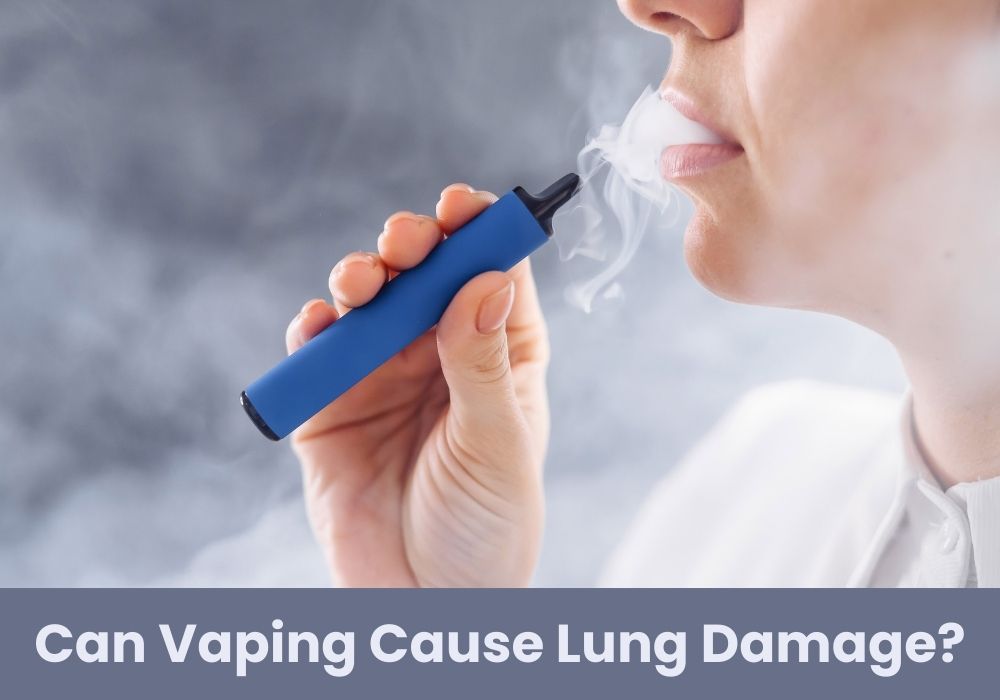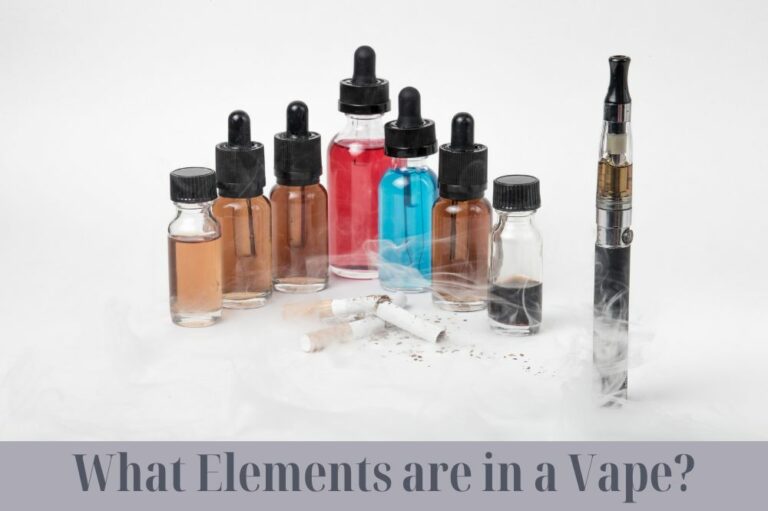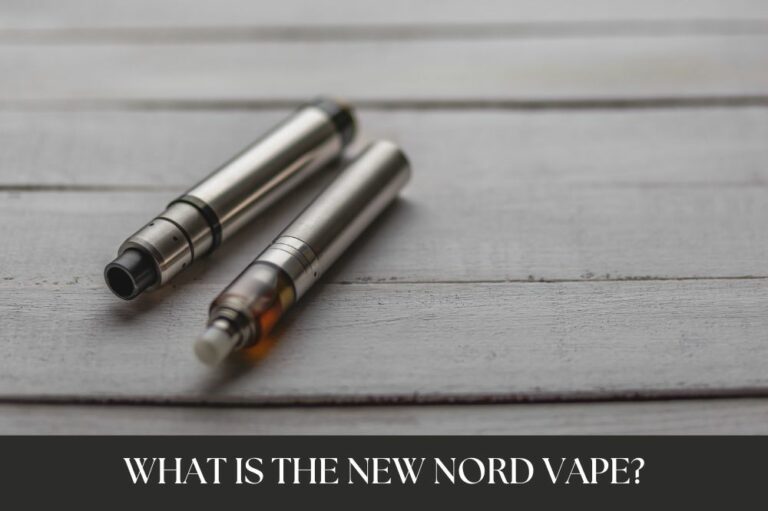
If you’re a vaper, you may have heard that vaping can cause lung damage. But is there any truth to this claim? The answer is yes, vaping can cause lung damage. While e-cigarettes are generally considered safer than traditional cigarettes, they still contain harmful chemicals that can damage your lungs over time.
One of the biggest concerns with vaping is the inhalation of harmful chemicals. E-cigarettes heat up a liquid that contains nicotine, flavorings, and other chemicals, and turn it into an aerosol that is inhaled into the lungs. This aerosol can contain harmful chemicals such as volatile organic compounds, cancer-causing chemicals, and heavy metals like nickel, tin, and lead. Over time, inhaling these chemicals can lead to lung damage and other health problems.
Another concern with vaping is the recent outbreak of lung injuries associated with e-cigarette use. According to the CDC, there have been over 2,800 cases of e-cigarette, or vaping, product use-associated lung injury (EVALI) reported in the United States. While the exact cause of EVALI is still unknown, it is believed to be related to the inhalation of harmful chemicals found in e-cigarettes. If you’re a vaper, it’s important to be aware of the potential risks associated with vaping and to take steps to protect your lung health.
Understanding Vaping
If you’re a smoker, you’ve probably heard about vaping as an alternative to smoking traditional cigarettes. Vaping involves inhaling vapor from an electronic cigarette or other vaping device. While vaping may seem like a safer alternative to smoking, it’s important to understand that there are still risks involved.
Vaping devices work by heating a liquid, which usually contains nicotine, flavorings, and other chemicals, to create a vapor that is then inhaled. This vapor can contain harmful chemicals, including heavy metals, volatile organic compounds, and cancer-causing chemicals. Inhaling these chemicals can cause damage to your lungs and other parts of your body.
One of the biggest risks associated with vaping is lung damage. While research on the long-term effects of vaping is still in the early stages, there is evidence to suggest that vaping can cause lung damage. In fact, a condition known as e-cigarette, or vaping, product use-associated lung injury (EVALI) has been linked to vaping.
Symptoms of EVALI can include coughing, shortness of breath, chest pain, fever, fatigue, and more. If you experience any of these symptoms after vaping, it’s important to seek medical attention right away.
In addition to lung damage, vaping can also have other negative effects on your health. Nicotine, which is present in most vaping liquids, is highly addictive and can cause a range of health problems, including increased heart rate, high blood pressure, and an increased risk of heart disease.
Overall, it’s important to understand the risks associated with vaping and make an informed decision about whether or not to use these devices. If you’re a smoker looking for an alternative to traditional cigarettes, there are other options available, such as nicotine replacement therapy or smoking cessation programs.
SPIRITBAR Katana BP10000
- Slender, leather-textured body reminiscent of a katana handle for an authentic samurai feel
- Unique samurai-inspired e-liquid flavor - fruity yet not too sweet, with a luxurious, elegant aroma
- Powerful 650mAh rechargeable battery for extended vaping time
- Large 18ml e-liquid capacity and 10,000 puff capacity
- Advanced mesh coil and e-liquid & power display screens for optimal vaping experience
The special juice captures the essence of the samurai spirit with its rich, smoothly pulsating flavor that brings new satisfaction with every puff. The device's slender, leather-textured design evokes the grip of a samurai's katana, making this product a perfect choice for beginner vapors.
The Anatomy of a Vape
When you take a puff from a vape, you are inhaling an aerosol that is produced by heating a liquid mixture. The liquid mixture, also known as e-juice or vape juice, usually contains propylene glycol, vegetable glycerin, flavorings, and nicotine.
The device itself is made up of several components, each with a specific function. Here’s a breakdown of the anatomy of a typical vape device:
Battery
The battery is the power source for the device. It provides the energy needed to heat the coil and vaporize the e-juice. Most vape batteries are rechargeable and come in different sizes and capacities.
Tank
The tank is the container that holds the e-juice. It usually has a capacity of 2-5 ml and is made of glass or plastic. Some tanks are refillable, while others are disposable.
SPIRITBAR Jack’s Flask 9000 Puffs
- Stylish pirate flask-shaped body providing an exciting vaping experience
- Delivering up to 9000 puffs per device
- 20ml e-liquid capacity with 50mg nicotine strength for satisfying throat hit
- Specialized pirate-themed e-juice flavors for rich, swirling taste
- Premium mesh coil optimizes flavor profile for maximum vaping enjoyment
This disposable vape captures the daring spirit of the high seas with its flask styling and signature pirate e-juice flavors. The extraordinary battery life provides 9000 indulgent puffs for extended vaping pleasure. Live boldly and freely with the Jack's Flask - a legendary vaping experience fit for a pirate's adventures.
Coil
The coil is the heating element that vaporizes the e-juice. It is made of a resistance wire, such as kanthal or nickel, and is wrapped around a wick made of cotton or another porous material. When the battery is activated, the coil heats up and vaporizes the e-juice on the wick.
Mouthpiece
The mouthpiece is the part of the device that you put in your mouth to inhale the vapor. It is usually made of plastic, metal, or ceramic and can be removable or fixed.
Overall, vaping involves heating a liquid mixture and inhaling the resulting aerosol. While the exact composition of the aerosol can vary depending on the specific e-juice and device used, it is clear that vaping can expose your lungs to potentially harmful substances.
Vaping and Lung Damage
If you are a vaper, you may wonder if vaping can cause lung damage. According to Medical News Today, although vaping is often considered a better alternative to smoking, it can still lead to lung damage. The long-term effects of vaping on the lungs are still unknown, but research on the subject is ongoing.
One of the main concerns with vaping is the inhalation of harmful chemicals. The aerosol produced by vaping contains nicotine, flavorings, and other chemicals. Some of these chemicals have been linked to lung damage. For example, Johns Hopkins Medicine reports that vaping can cause inflammation and damage to the airways, which can lead to breathing difficulties.
In addition to the chemicals in the aerosol, the heating coils in vaping devices can also release harmful metals. According to Harvard Health Publishing, repeated use of refillable cartridges can cause metal heating coils to decompose, releasing toxic metals like manganese and zinc, which can cause illness when ingested at high levels. There are also case reports of lung injury linked to vaping-related metal exposure.
Furthermore, vaping has been associated with a condition known as vaping-associated pulmonary injury (VAPI), also called e-cigarette or vaping product use-associated lung injury (EVALI). According to NCBI Bookshelf, VAPI is an acute or subacute respiratory illness characterized by a spectrum of clinicopathologic findings mimicking various pulmonary diseases. The cause of VAPI is not entirely clear, but it appears to be linked to the use of certain types of vaping products.
Overall, while the long-term effects of vaping on the lungs are still unknown, there is evidence to suggest that vaping can cause lung damage. If you are a vaper, it is essential to be aware of the potential risks and to take steps to protect your lung health.
Types of Lung Damage
Vaping can cause various types of lung damage, including:
Inflammation
Inhaling vaporized e-liquid can cause inflammation in your lungs. This inflammation can lead to coughing, wheezing, and shortness of breath. In some cases, it can also cause chest pain and fever.
Chemical Irritation
Vaping exposes your lungs to a variety of chemicals that can irritate the delicate tissues in your respiratory system. Some of the chemicals found in e-liquid, such as formaldehyde and acrolein, are known to cause respiratory irritation and can damage the lining of your lungs.
Lung Scarring
In some cases, vaping can cause lung scarring, also known as pulmonary fibrosis. This condition occurs when the delicate tissues in your lungs become damaged and scarred, making it difficult to breathe. Symptoms of pulmonary fibrosis include shortness of breath, fatigue, and a persistent cough.
Popcorn Lung
Popcorn lung is a rare but serious condition that can be caused by vaping. This condition is caused by inhaling diacetyl, a chemical used to give some e-liquids a buttery flavor. Popcorn lung can cause shortness of breath, wheezing, and coughing, and in severe cases, it can be fatal.
SPIRITBAR Katana BP10000
- Slender, leather-textured body reminiscent of a katana handle for an authentic samurai feel
- Unique samurai-inspired e-liquid flavor - fruity yet not too sweet, with a luxurious, elegant aroma
- Powerful 650mAh rechargeable battery for extended vaping time
- Large 18ml e-liquid capacity and 10,000 puff capacity
- Advanced mesh coil and e-liquid & power display screens for optimal vaping experience
The special juice captures the essence of the samurai spirit with its rich, smoothly pulsating flavor that brings new satisfaction with every puff. The device's slender, leather-textured design evokes the grip of a samurai's katana, making this product a perfect choice for beginner vapors.
EVALI
EVALI, or e-cigarette or vaping product use-associated lung injury, is a condition that can be caused by vaping. Symptoms of EVALI include shortness of breath, coughing, chest pain, and fever. In severe cases, it can cause respiratory failure and even death. While the exact cause of EVALI is not yet known, it is thought to be related to inhaling harmful chemicals found in some e-liquids.
Studies on Vaping and Lung Damage
Recent Research
Several studies have been conducted in recent years to investigate the effects of vaping on lung health. One study published in the Harvard Gazette in 2022 found that chronic vaping can lead to progressive lung damage. The study observed that patients who vaped regularly experienced similar types of lung damage, which improved partially after they stopped vaping. The researchers concluded that vaping was the most likely cause of the lung damage after excluding other possible causes.
Another study published on PubMed in 2021 highlighted the potential harms of vaping, especially on the respiratory system. The study concluded that relatively little is known about the effects of chronic vaping on the lungs.
Long-Term Studies
Long-term studies on the effects of vaping on lung health are still ongoing. However, some studies have provided insights into the potential long-term risks of vaping. For instance, a study published by the American Lung Association found that e-cigarettes produce dangerous chemicals, including acetaldehyde, acrolein, and formaldehyde, which can cause lung and cardiovascular diseases. The study also found that e-cigarettes contain acrolein, a herbicide that can cause acute lung injury, COPD, asthma, and lung cancer.
Another study published in the National Center for Biotechnology Information found that vaping can cause lung damage due to the toxic agents present in the aerosolized liquid vapor. The study also highlighted the risks of vaping-associated lung injury, which can manifest as an acute respiratory illness.
Overall, while more research is needed to fully understand the long-term effects of vaping on lung health, the available studies suggest that chronic vaping can cause lung damage and other respiratory problems.
Symptoms of Lung Damage
If you are a vaper, it is important to be aware of the symptoms of lung damage. The following symptoms may indicate that you have lung damage caused by vaping:
- Coughing: If you are coughing persistently, it may be a sign that your lungs are damaged.
- Shortness of breath: If you are having difficulty breathing or feeling short of breath, it may be a sign that your lungs are not functioning properly.
- Chest pain: If you are experiencing chest pain or discomfort, it may be a sign that your lungs are damaged.
- Wheezing: If you hear a whistling sound when you breathe, it may be a sign that your airways are narrowed due to lung damage.
- Fatigue: If you feel tired or weak, it may be a sign that your lungs are not getting enough oxygen.
If you experience any of these symptoms, it is important to seek medical attention immediately. Ignoring these symptoms can lead to further lung damage and other health problems.
It is also important to note that some people may not experience any symptoms of lung damage, even if they have been vaping for a long time. This does not mean that their lungs are not damaged, however. If you are a vaper, it is important to get regular check-ups with your doctor to monitor your lung health.
Prevention and Risk Reduction
If you are concerned about the potential lung damage caused by vaping, there are several steps you can take to reduce your risk:
- Quit vaping: The most effective way to reduce your risk of lung damage from vaping is to quit vaping altogether. If you are struggling to quit, consider seeking support from a healthcare provider or a smoking cessation program.
- Avoid black market products: Many of the cases of vaping-related lung damage have been linked to the use of black market vaping products. To reduce your risk, only use vaping products that are purchased from reputable retailers.
- Use lower nicotine concentrations: High nicotine concentrations have been linked to an increased risk of lung damage from vaping. To reduce your risk, consider using vaping products with lower nicotine concentrations.
- Avoid flavorings: Many of the chemicals used to flavor vaping products have been linked to lung damage. To reduce your risk, consider using unflavored vaping products.
- Monitor your symptoms: If you experience any symptoms of lung damage, such as coughing, shortness of breath, or chest pain, seek medical attention immediately.
By taking these steps, you can reduce your risk of lung damage from vaping. However, it’s important to remember that the long-term effects of vaping are not yet fully understood, and there may be additional risks that have not yet been identified.
Medical Views on Vaping
Vaping has become increasingly popular in recent years, especially among young adults. However, medical professionals have expressed concern about the potential health risks associated with vaping. Many studies have shown that vaping can cause lung damage, among other health problems.
According to a study published in The BMJ, vaping can have a significant impact on respiratory health. The study found that vaping-related acute lung injury can occur due to the inhalation of oily substances found in e-liquid. This can lead to an inflammatory response in the lungs, resulting in symptoms such as chronic cough, shortness of breath, and coughing up blood or blood-tinged mucus.
Another study conducted by researchers at Harvard University found that chronic vaping can cause progressive lung damage. The study observed patients who had been vaping for an extended period and found that they exhibited similar types of lung damage. The researchers concluded that vaping was the most likely cause of the lung damage.
In addition to causing lung damage, vaping has been linked to other health problems such as heart disease, stroke, and cancer. The American Lung Association has also expressed concern about the potential for secondhand exposure to harmful chemicals from vaping.
Overall, medical professionals recommend avoiding vaping altogether to reduce the risk of lung damage and other health problems. If you are currently vaping, it is recommended that you speak with your doctor about the potential risks and consider quitting.
Public Perception of Vaping
Vaping has become increasingly popular in recent years, with many people turning to it as an alternative to smoking. However, the public perception of vaping is mixed, with some people believing that it is a safe alternative to smoking and others expressing concerns about the potential health risks.
One of the main concerns about vaping is that it can cause lung damage. While some studies have suggested that vaping can lead to respiratory issues, others have found no evidence of harm. The perception that vaping takes less than a year to harm users’ health and worry that vaping will damage health also persists [1].
Media reporting should be responsible and balanced, as it can shape vaping harm perceptions [1]. The 2019 E-cigarette or Vaping Use-Associated Lung Injury (EVALI) outbreak highlighted the potential harms of vaping, and the consequences of long term use remain unknown [2].
It is important to note that vaping is still a relatively new phenomenon, and more research is needed to fully understand its potential health risks. In the meantime, it is important to approach vaping with caution and to be aware of the potential risks associated with it.
If you are a regular vaper, it is important to monitor your health and seek medical attention if you experience any respiratory symptoms such as coughing, wheezing, or shortness of breath [4]. Additionally, it is recommended to avoid using any black market or unregulated vaping products, as they may contain harmful substances that can cause lung damage [3].
Overall, the public perception of vaping is complex and evolving. It is important to stay informed about the latest research and to approach vaping with caution.
Vaping Regulations
When it comes to vaping, there are regulations in place to help protect consumers. These regulations vary by country and state, but they generally cover areas such as age restrictions, product labeling, and manufacturing standards.
In the United States, for example, the Food and Drug Administration (FDA) regulates the manufacturing, marketing, and distribution of e-cigarettes and other vaping products. The FDA has established a minimum age of 18 for the purchase of tobacco products, including e-cigarettes, and has also implemented regulations around the packaging and labeling of these products.
Similarly, in the European Union, the Tobacco Products Directive (TPD) regulates the sale and marketing of tobacco products, including e-cigarettes. The TPD includes provisions for product labeling, advertising restrictions, and manufacturing standards.
Some countries have gone even further in their regulations. For example, in Australia, the sale and use of nicotine-containing e-cigarettes is illegal. In Canada, the sale of e-cigarettes is legal, but the products must be approved by Health Canada before they can be sold.
Overall, these regulations are designed to help ensure that vaping products are safe and that consumers are protected. However, it’s important to note that regulations alone may not be enough to prevent all cases of vaping-related lung damage. It’s always important to use caution and to be aware of the potential risks associated with vaping.








